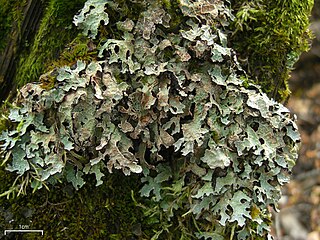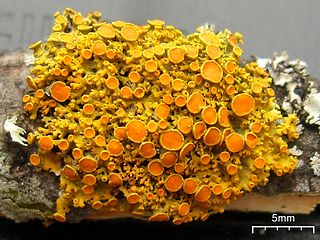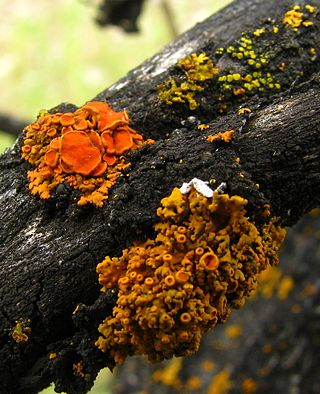
The Teloschistaceae are a large family of mostly lichen-forming fungi belonging to the class Lecanoromycetes in the division Ascomycota. Collectively, the family has a cosmopolitan distribution, although members occur predominantly in subtropical and temperate regions. Although most members are lichens that either live on rock or on bark, about 40 species are lichenicolous – meaning they are non-lichenised fungi that live on other lichens. Many members of the Teloschistaceae are readily identifiable by their vibrant orange to yellow hue, a result of their frequent anthraquinone content. The presence of these anthraquinone pigments, which confer protection from ultraviolet light, enabled this group to expand from shaded forest habitats to harsher environmental conditions of sunny and arid ecosystems during the Late Cretaceous.
Neobrownliella brownlieae is a species of saxicolous (rock-dwelling), crustose lichen in the family Teloschistaceae. It is widely distributed in Australia.

Teloschistes chrysophthalmus, sometimes referred to as the gold-eye lichen or golden-eye, is a fruticose lichen with branching lobes. Their sexual structures, apothecia, are bright-orange with spiny projections situated around the rim.

Parmelia barrenoae is a species of foliose lichen in the large family Parmeliaceae. It was formally described as a new species in 2005. Before this, it was lumped together as one of several lichens in the Parmelia sulcata group—a species complex of genetically distinct lookalikes. Parmelia barrenoae is widely distributed, occurring in Europe, western North America, Africa, and Asia.
Huneckia is a genus of crustose lichens in the subfamily Caloplacoideae of the family Teloschistaceae. It has four species.
Lecanora lojkahugoi is a species of saxicolous (rock-dwelling) crustose lichen in the family Lecanoraceae. It is found in the Russian Far East and in South Korea.
Gallowayella aphrodites is a species of corticolous (bark-dwelling), foliose (leafy) lichen in the family Teloschistaceae. It is found in the Mediterranean countries Greece, Cyprus, and Italy. Characteristics of the lichen include its small thallus, the disposition of the rhizines on the thallus undersurface, and the lack of vegetative propagules.
Aridoplaca is a fungal genus in the family Teloschistaceae. It is a monotypic genus, containing the single saxicolous (rock-dwelling) squamulose lichen species Aridoplaca peltata, found in South America. The genus was circumscribed in 2021 by Karina Wilk, Maciej Pabijan, and Robert Lücking, following molecular phylogenetic analysis that showed the species occupies a distinct lineage in the subfamily Xanthorioideae of the Teloschistaceae. The species epithet peltata refers to the squamulose and peltate thallus, while the genus name refers to the habitat of the lichen, which occurs in arid areas of Bolivia and Peru. It grows in well-lit areas on siliceous rocks at altitudes between 3,500 and 4,500 m.

Gallowayella hasseana, the poplar sunburst lichen, is a species of corticolous (bark-dwelling), crustose lichen in the family Teloschistaceae. It occurs in North America.
Cinnabaria is a monospecific fungal genus in the family Teloschistaceae, represented by its sole species, Cinnabaria boliviana. This lichen, found only in Bolivia, is distinguished by its unique genetic signature, as well as morphological characteristics like ascospore size and other traits. Despite its resemblance to certain species from the Caloplaca cinnabarina species complex, Cinnabaria boliviana belongs to a distinct genetic lineage.
Opegrapha ramisorediata is a rare species of corticolous (bark-dwelling), crustose lichen in the family Opegraphaceae. Known to occur only in northeastern Brazil, it was described as a new species in 2017. It is characterised by a thin, pale greenish-mauve thallus.

Niorma is a genus of lichen-forming fungi in the family Teloschistaceae. It has six fruticose species, with N. derelicta assigned as the type species. The genus was originally proposed by Italian lichenologist Abramo Bartolommeo Massalongo in 1861, but this and several other genera he proposed were largely ignored by later contemporaries. As part of a molecular phylogenetics-led restructuring of the teloschistoid clade of the subfamily Xanthorioideae in the Teloschistaceae, Sergey Kondratyuk and colleagues resurrected the genus for use about 150 years later. Genus Niorma comprises what was previously known as a species complex centred around the taxon previously known as Teloschistes hypoglaucus.
Elixjohnia is a genus of lichen-forming fungi in the family Teloschistaceae. It has four species of saxicolous (rock-dwelling), crustose lichens that occur in Australasia.
Solitaria is a fungal genus in the family Teloschistaceae. It contains a single species, the corticolous (bark-dwelling), crustose lichen Solitaria chrysophthalma.
Xanthoria yorkensis is a species of corticolous (bark-dwelling), crustose lichen in the family Teloschistaceae. Found in South Australia, it was formally described as a new species in 2009 by lichenologists Sergey Kondratyuk and Ingvar Kärnefelt. The type specimen, collected along the Maitland road in Yorke Peninsula, was found growing on Melaleuca trees in mallee scrub. The species epithet refers to its type locality, the only place the lichen is known to occur. Kondratyuk and colleagues proposed to transfer the taxon to the newly circumscribed Jackelixia in 2009, but this genus has not been widely accepted by other authorities.
Xanthoria kangarooensis is a species of corticolous (bark-dwelling), crustose lichen in the family Teloschistaceae. Found in Australia, it was formally described as a new species in 2009 by lichenologists Sergey Kondratyuk and Ingvar Kärnefelt. The type specimen was collected from East Kangaroo Island, where it was found growing on dead Lycium ferocissimum shrubs. Other associated lichens include species of Pyxine, Ramalina, and Rinodina. The species epithet kangarooensis refers to its type locality, the only place the lichen is known to occur. Kondratyuk and colleagues proposed to transfer the taxon to the newly circumscribed Jackelixia in 2009, but this genus has not been widely accepted by other authorities.
Anaptychia ethiopica is a species of lichen in the family Teloschistaceae. Found in East Africa, China, and Russia, it was formally described as a new species in 1976 by lichenologists Thomas Douglas Victor Swinscow and Hildur Krog. The type specimen was collected from Mount Bwahit, where it was found growing on moss.

Gallowayella montana is a species of corticolous (bark-dwelling) lichen in the family Teloschistaceae. It occurs in North America.
Placomaronea fuegiana is a species of saxicolous (rock-dwelling), crustose lichen in the family Candelariaceae. Found in South America, it was formally described as a new species in 2009 by Martin Westberg and Patrik Frödén. The type specimen was collected by the second author in Tierra del Fuego, Argentina, where it was found growing on sandstone. The species epithet fuegiana refers to the type locality. It also occurs in Pali-Aike National Park, where it grows in the pits of volcanic rocks.
Marchantiana is a genus of lichen-forming fungi in the family Teloschistaceae. It contains seven species of corticolous (bark-dwelling), crustose lichens that occur in the Southern Hemisphere.





